Fiat Currency Economic Death Spiral Has Been Triggered
Economics / Fiat Currency May 28, 2011 - 11:04 AM GMTBy: Gordon_T_Long
 For nearly 30 years we have had two Global Strategies working in a symbiotic fashion that has created a virtuous economic growth spiral. Unfortunately, the economic underpinnings were flawed and as a consequence, the virtuous cycle has ended. It is now in the process of reversing and becoming a vicious downward economic spiral.
For nearly 30 years we have had two Global Strategies working in a symbiotic fashion that has created a virtuous economic growth spiral. Unfortunately, the economic underpinnings were flawed and as a consequence, the virtuous cycle has ended. It is now in the process of reversing and becoming a vicious downward economic spiral.
One of the strategies is the Asian Mercantile Strategy. The other is the US Dollar Reserve Currency Strategy.
These two strategies have worked in harmony because they fed off each other, each reinforcing the other. However, today the realities of debt saturation have brought the virtuous spiral to an end.
One of the two global strategies enabled the Asian Tigers to emerge and grow to the extent that they are now the manufacturing and potentially future economic engine of the world.
The other allowed the US to live far beyond its means with massive fiscal deficits, chronic trade imbalances and more recently, current account imbalances. The US during this period has gone from being the richest country on the face of the globe to the biggest debtor nation in the world.
First we need to explore each strategy, how they worked symbiotically, what has changed and then why the virtuous cycle is now accelerating into a vicious downward spiral.
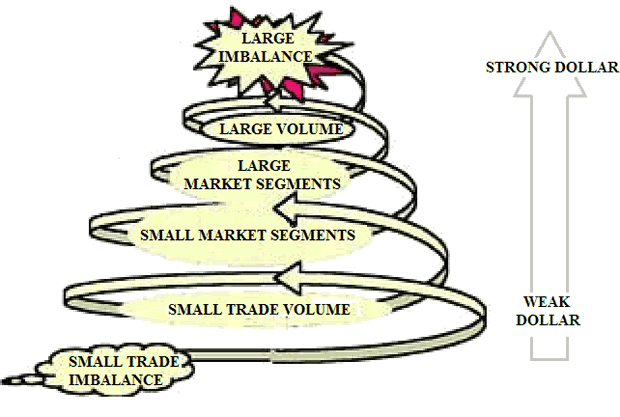
ASIAN MERCANTILE STRATEGY
The Asian Mercantile Strategy started with the emergence of Japan in the early 1980s, expanded with the Asian Tigers in the 90s and then strategically dominated with China in the first decade of this century.
Initially, Japan's products were poor quality and limited to cheap consumer products. Japan as a nation had neither the raw materials, capital markets, nor domestic consumption market to compete with the giant size of the USA.
To compensate for its disadvantages, Japan strategically targeted its manufacturing resources for the US market. By doing this, the resource poor island nation took the first step in becoming an export economy - an economy centered on growth through exports versus an economy like the US, where an excessive 70% of GDP is dependent on domestic consumption.
The strategy began to work as Japan took full advantage of its labor differential that was critical in the low end consumer product segment, which it initially targeted. Gradually, as capital availability expanded, Japan broadened its manufacturing scope, moving into higher levels of consumption products requiring higher levels of quality and achieving brand recognition.
Success soon became a problem as the Yen began to strengthen. To combat this the Japanese implemented the second critical component of what became the Asian Mercantile Strategy template. It began to manipulate its currency by aggressively intervening in the forex market to keep the yen weak.
Further success forced Japan to move to a more aggressive forex strategy to maintain a currency advantage. It was strategically decided that Japan's large and growing foreign reserves were to be re-invested back into the US. By buying US Agency and US Treasury debt instruments it kept the dollar strong relative to the Yen. The more successful Japan became, the more critical this strategy became. In the 80s Japan dominated global expansion as it brought US automotive and consumer electronics' manufacturing to its knees.
By the early 90s the Japanese labor advantage was quickly being lost to the Asian Tigers because the Yen versus the Asian Tiger currencies was too strong. The Asian Tigers were following the Japanese model. The Asian Crisis in 1997 re-enforced to all Asian players the importance of holding large US dollar denominated reserves. This further accelerated and reinforced the strategy of purchasing US Treasury and Agency debt.
With China's acceptance into the World Trade Organization (WTO), China emerged on the scene in full force. Armed with the lessons of the last twenty years, China took the Asian Mercantile Strategy to another level in its ongoing evolution.
The results were one of the largest and fastest transfers of industrial power ever to occur in history. In ten years, China assumed the role of the world's undisputed industrial powerhouse in the world.
The virtuous cycle further accelerated as Asia became more dominant because its reserves, reinvested back in the US, began to have a larger and larger impact. The more Asia bought US Treasury and Agency debt, the lower US interest rates were forced, allowing Americans to finance more and more consumption. The more Asia bought US securities, the stronger the US dollar was against Asian currencies, and therefore the cheaper Asian products were relative to US manufactured products. It was a self reinforcing Virtuous Cycle.
The result was a staggering 46,000 factories transferred from the US to Asia over the same 10 year period. The transfer set the stage for chronic unemployment and public funding problems, but it was temporarily hidden by equally massive increases in debt spending.
The low interest rate driven housing bubble, being of historic proportions, made Americans feel richer than they were. They took on excess debt in various forms such as Home Equity Loans (HELOCs) at unprecedented levels. The acceleration of debt materially impacted both the GDP and employment of the nation through Real Estate, Construction and Mortgage Finance job growth further hiding underlying problems.
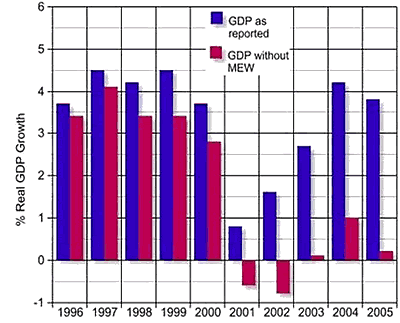
US DOLLAR RESERVE CURRENCY STRATEGY
Since President Richard Nixon took the US off the Gold Standard in 1971, the US has adopted what I refer to as the US Dollar Reserve Strategy. After the Second World War, at the Bretton Woods Conference, the US dollar was accepted as the world's reserve currency and as such was pegged to Gold at a fixed rate of $35/oz. due to massive Vietnam war costs and President Johnson Great Society, the US could no longer honor its agreement. In 1971, when France demanded conversion payment in Gold, the US refused. At this point the US become a fiat currency, not backed by anything other than the full faith and credit of Washington politicos.
What were other countries to do in retaliation? What quickly became evident was there was little they could do. The fact was that international trade was conducted in US dollars as a matter of necessity due to the dominance of US export trade; and as such, nations were forced to have US dollars to transact international trade.
Additionally, the US established agreements with oil producing Middle East countries that oil could only be sold in US dollars. Since energy is a dominant import cost for most nations, this secured the strategic position and requirement that the US dollar would be maintained as the preeminent reserve currency by trading nations.
What this strategy meant to the US was that it could now print money, and effectively export the potential inflationary consequences of its actions. The 1970s were initially marked by dramatic increases in US inflation as the strategy took hold and was implemented. By the time of President Reagan's presidency, the strategy was working thanks to some herculean efforts by Chairman Volker at the Federal Reserve. This well executed strategy is what I refer to as the US Reserve Currency Strategy.
The strategy allowed Regan to implement 'Reaganomics' and his new Supply Side economic policies which launched the longest bull market in US history. Further enhanced by an extremely loose monetary policy under Greenspan, relaxed reserve requirements under Clinton, and tax cuts under George Bush II, the US moved quickly from being the world's richest country to being the world's largest debtor.
Historic debt growth was built up without the disease of inflation infecting the US economy. This is explained by inflation that was effectively exported whenever increasing levels of US dollars were printed by the US Treasury.
Any threat to this strategy was rapidly challenged by US military power. As an example, when Saddam Hussein, President of Iraq, decided to sell Iraq oil denominated in Euros, he was invaded by US forces three months later and removed from power. When Libyan leader Muammar Gaddafi wanted gold in exchange for Libyan oil, he almost immediately found himself the target of US planned military intervention.
Presently, oil is still sold only in US dollars, but more and more trade deals are being negotiated between China and its trading partners. This is a serious threat to the US and the US Dollar Reserve Strategy.
THE SYMBIOTIC RELATIONSHIP
One of the reasons the US Reserve Strategy has worked for as long as it has, is because there was an incentive by other countries to sterilize the US dollars they received. This, in the case of Asia, was because of the Asian Mercantile Strategy they were executing. By sterilizing US dollars, they held down their currency's exchange rate, which helped their exports though creating potential domestic inflation. Until recently, these inflation pressures have been manageable.
In the case of Europe, the Euro was only coming into existence in the late 90s, but then quickly moved from well below par to nearly 1.50 to the US dollar, causing competitive problems for European export trade for many peripheral countries (PIIGS).
The Asian Export Strategy and the US Reserve Dollar Strategy were symbiotic for a number of reasons:
-
Though the Asian Export Strategy was an Export Trade Imbalance game and the US Dollar Reserve Strategy a Volume Trade game, both were centered on global trade. The US won by increased global trading and the growing requirement for the US dollars it required - dollars that could be increased to pay for the military industrial complex without increasing taxation and used as reserves for global banking growth. Asia won by getting an ever increasing share of a growing volume of trade.
-
The US as a 70% consumption economy needed cheap financing to sustain its insatiable consumption. Asia needed consumption to absorb its growing exports.
-
The US needed a strong dollar to attract financing for its debt. Asia saw US debt as a store for its growing reserves that additionally reduced financing costs for its export products. In a way Asia was offering a form of vendor financing or 'lay away' financing.
-
US corporations saw 'off-shoring', 'outsourcing' and 'rightsizing' as major productivity improvements. The Asian Mercantile Strategy offered American corporations an opportunity to significantly increase profitability while Asia needed every increasing and larger market segments to penetrate. US corporations brought know-how, branding and capital to the Asian economies who desperately needed these strengths to employ unskilled populations, increase standards of living and reduce the always present and potential social unrest.
-
The US economy which had shifted from an industrial economy to a services economy was quickly becoming a financial economy with 44% of the stock market being financials. The financial economy needed increasing capital inflows to sustain itself.
WHAT HAS CHANGED
So what could possible stop this ideal symbiotic relationship from continuing to feed on itself?

A number of factors, all of which are now coming together to end this Virtuous Cycle.
DEBT SATURATION
I recently authored a paper entitled Debt Saturation & Money Illusion, that if you have not read, I encourage you to read since it would take up too much space here. It makes the case that the global economy has reached the point where annual debt costs are now outstripping the global economy's ability to support the exponentially increasing burden.
Additionally, stimulus spending by governments has now reached the point where it is actually counterproductive.
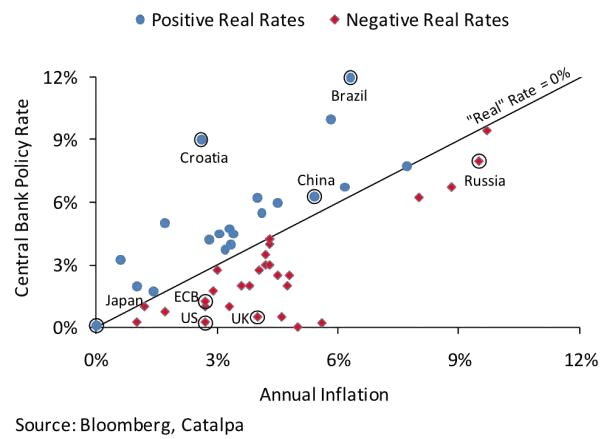
The above chart shows that even using government numbers for inflation (which are disgracefully inadequate and understated) the real rates in the old industrialized economies are negative. By contrast, rates in emerging economies are positive.
This means central banks are effectively paying banks to take money, yet commercial banks cannot find sufficient investments to actually absorb the money. Like pushing on a string, the global economy simply cannot absorb debt at the levels required to sustain required growth rates which must exceed inflation rates.
The level of nonperforming bank assets is growing at such a rate that global banks have serious concerns with their existing loans and potentially their own solvency.
Growth in Non Performing Bank Loan Levels is shown below.
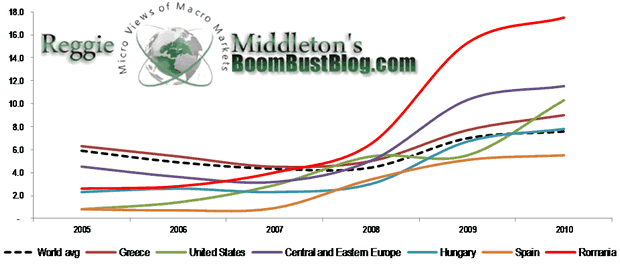
MALINVESTMENT
I found a recent article entitled: Technology firms struggle to cover interest payments in the Korean Times to be very instructive. Despite Asian economies growing rapidly and now dominating the global electronics industry, the study by the Korean Times found alarmingly that:
- One in three firms traded on the Kosdaq stock exchange failed to earn sufficient money to cover their interest payments in 2010.
- 280 out of 876 Kosdaq-listed corporations, or 32 percent, could not reach the benchmark reading of one in the interest coverage ratio. The interest coverage ratio, otherwise dubbed times interest earned (TIE), refers to the measure of a firm's ability to honor its debt payments.
This is classic mal-investment in the truest sense of the Austrian School of Economcis.
Corporations now have balance sheets so leveraged with debt that their business models are barely able to cover debt payments even when interest rates are at historic lows. What does this suggest for possible debt default and forced unwinding going forward?
Private Equity corporations with leveraged takeovers and buyouts dominated the US financial landscape for years. These takeovers left corporate balance sheets severely damaged and barely able to pay the debt burdens they were forced to assume.
Additionally, we have learned since the days of Enron, there are significant amounts of debt held off balance sheets today in Special Purpose Entities (SPEs). There is no investor transparency to these obligations. This debt and other forms of 'contingent liability' reporting presently allow corporations to assume ever larger amounts of debt without impacting their corporate credit ratings. Everything works fine until growth slows.
Corporations over the last decade are acting more as highly leveraged hedge funds with the consequential exposure of margin or collateral calls. This is a highly risky and unstable situation in the longer term.
CONSUMPTION IMBALANCES
Another factor causing the unwind is a tapped out US consumer. This has been forecast for over a decade as an eventuality, but the US consumer continued to surprise everyone with their willingness to consume and take on debt. However, since the 2008 financial crisis things have changed. The US real disposable income has fallen and US consumer debt loads are now impacting their ability to consume.
Consumption growth rates in the US have slowed. The Asian economies have consumption rates below forty percent. The consumption growth rates of these Asian economies, though growing, are increasing from a much smaller absolute size. This imbalance is placing further pressures on the symbiotic relationship.
A VIRTUOUS RISING CYCLE BECOMES A VICIOUS DOWNWARD SPIRAL
Slowly, the cycle is reversing. What was once a virtuous cycle is now a potentially vicious downward spiral.
The death knell for the cycle will be:
-
A deteriorating US dollar,
-
Rising US interest rates,
-
Sustained and chronic US unemployment,
-
Asian inflation, especially in food where 60% of Asian disposable income is spent.
-
Pressures on Asian currency pegs
-
Collapsing values of US Reserve holdings.
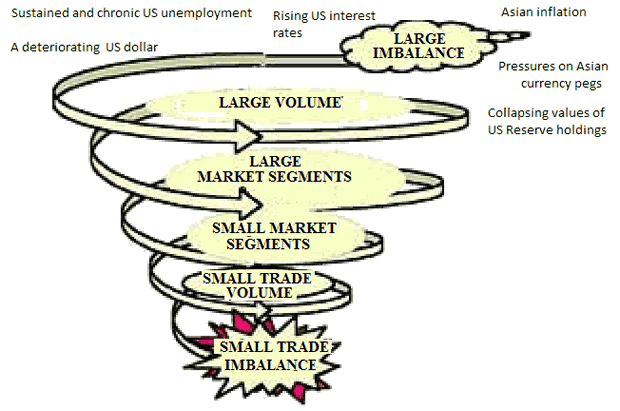
BERNANKE'S BOX
I recently published another paper entitled BERNANKE'S QEx BOX! where I argued what Chairman Ben Bernanke was likely to do at his critical April 27th FOMC 'Signal' meeting. I was proven right as he delivered precisely on cue. It was not a difficult call.
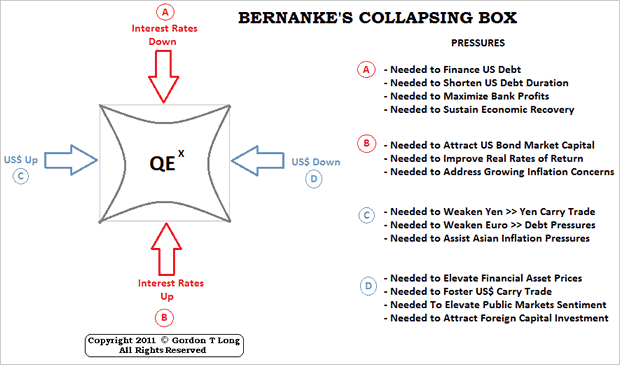
The reason I was so sure is because the real problem was clear. It is about what the Basel BIS (Bank of International Settlements) Bankers are more than aware of.
As I point out in Debt Saturation & Money Illusion, the Shadow Banking liabilities have fallen by $5 Trillion since the financial crisis, which is a crushing blow to global liquidity and in fact global financial banking solvency.
An analysis of data by Fathom Consulting for the US Federal Reserve, the European Central Bank, the Bank of Japan and the Bank of England, showed their assets swelled from around $4 trillion at the start of 2006 to just short of $9 trillion by the end of February this year. The increase in the size of G4 central bank balance sheets since mid-07 has ALSO been around $5 trillion to end February 2011, or 8 percent of global GDP.
It is my view that the Basel BIS Bankers have orchestrated their balance sheet growth to offset the contracting Shadow Banking System liabilities. For those that are not aware, Federal Reserve Chairman Ben Bernanke, Bank of England Governor Mervyn King, ECB President Jean-Claude Trichet and Bank of Japan Governor Masaaki Shirakawa all sit as Board Members and meet regularly.
FED'S DUAL TRIPLE MANDATE
To do this the central bankers have increased their balance sheets to their political limits which can be seen in the following Federal Reserve chart from Zeal.
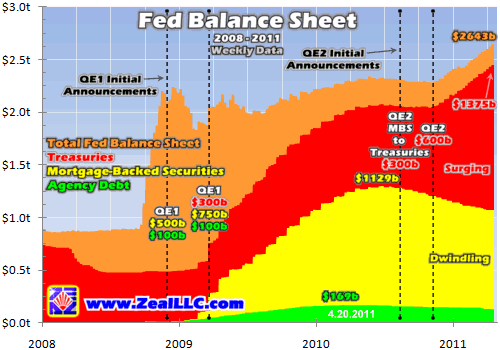
In the case of the US Federal Reserve, this has meant such significant changes that effectively the Fed's dual mandate has now expanded to three. Besides the official mandates of Full Employment and Price Stability, a third has been added: Asset Appreciation.
This is clearly evident when we overlay the above balance sheet growth with US equity market appreciation, as represented by the S&P 500 in the chart below.
The top of the red Treasury series (chart above) represents the total Treasuries, MBSs, and agencies the Fed purchased in its quantitative-easing campaigns. That red line above is then transferred to the second chart below as total QE . Superimposed on top of it is the US stock markets as represented by the SPX (blue). The strong correlation between the Fed's monetization and the post-panic stock-market recovery is remarkable, perhaps even scary.
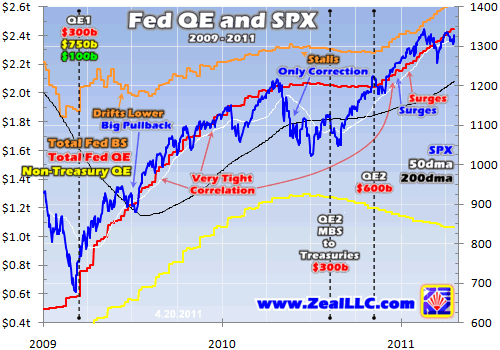
The Federal Reserve is no longer the "Lender of Last Resort"
The Federal Reserve is now the "Buyer of First Resort"
INHERENT LIMITER: INFLATION
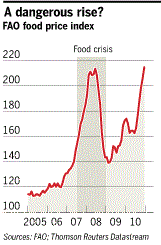
There can be little doubt, despite Federal Reserve rhetoric, that Quantitative Easing , ZIRP (Zero Interest Rate Policy) and negative real interest rates have caused a surge in global inflation rates.
Recently Oil was at a 31 Month high and up 22 percent Year-on-Year. Corn was up 90 percent, Wheat and Soybeans up 45 percent and Rice at yet another high.
This inflation has been acutely felt throughout Asia which has to combat this in parallel with trying to keep their currencies competitive as part of their Asian Mercantile strategy.
Across Asia, interest rates and bank reserve requirements have been increased, and in some instance capital control restrictions implemented. Pressures are such that many, including China, are now at the point of surrendering sacrosanct currency appreciation.
The problem is food inflation. Food must be imported and a stronger currency would help avoid consumer sensitive food inflation, at the expense of assisting with its own export strategy.
Sixty percent of disposable income in Asia, according to the Asian Development Bank (ADB) in a major report entitled: Global Food & Price Inflation & Developing Asia, is spent on food. Food is presently expected to average 10 percent inflation in 2011. This has created tremendous pressures on the population and potential social unrest for Asian governments.
64 Million people have already been moved into the category of poverty, which the ADB classifies as below $1.25/day. With 3.5 Billion consumers, it is expected that 190 Million will be pushed into poverty if food inflation continues. Food prices were up 30% in February's report, so the 10 percent Asian food inflation is no doubt seriously too low.
GLOBAL SLOWDOWN - Q1 GDP SIGNALS
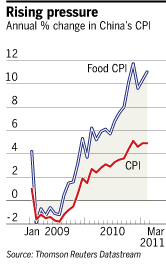
The efforts to fight inflation are now impacting the 7.8% Asian growth rate, which is now demonstrating the expected signs of slowing.
US Gross domestic product was recently reported as rising only 1.8 percent from January through March, after a 3.1 percent pace in the last three months of 2010. Taking out inventory builds this number as only 0.8 percent.
Britain reported 0.5 percent growth and is now on the edge of a double dip.
The Federal Reserve and most economists are all revising 2011 GDP growth lower, as a steady stream of negative news hits the markets.
If GDP numbers were adjusted for true inflation, rather than the suspect government CPI distortions, real GDP would be negative. Considering government deficit spending is now 20-25 percent of the US economy, can there be any question that we have effectively very negative economic growth?
The Basel BIS Bankers are acutely aware of this.
QEX WILL HAPPEN - 'The Risk-Off that Refreshes'
So what is to be done?
I believe a decision has been taken to temporarily remove some of the pressures off increasing money supply before resuming expansion of money and credit later in Q3 or Q4. There is little choice.
Make no mistake about it however, central bank money printing must continue and at an accelerated rate. I suspect it will emerge not as QE III, but in another form to address the massive and growing problems with non-performing assets, foreclosures and REOs occurring at Fannie, Freddie and the FHA.
Don't get fooled. Watch the balance sheets of the central banks. They will by necessity continue to grow to stop the vicious spiral from accelerating.
CONCLUSIONS
The Basel BIS Bankers fully understand the underpinnings of the shift from a Virtuous Cycle to a Vicious Spiral presently underway.
They are doing everything within their power to offset it. Policies of "extend and pretend" and "kick the can down the road" are all just attempts at buying time.
Unfortunately time is working against them, as existing debt only increases as interest owed is relentlessly and cumulatively added.
The Basel BIS Bankers have no real answers. The eventuality of a fiat currency crisis is ordained and has been since the early warnings in 2007 of the Financial Crisis. The roadmap has been clear to all that actually wanted to look.
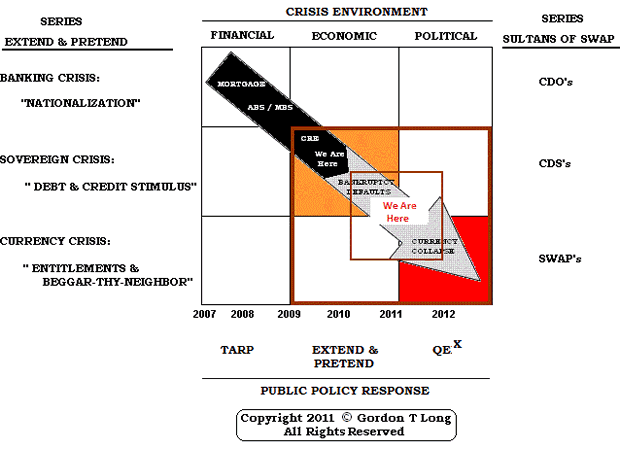
Listen to FREE Global Insights audio, 3 times a week at www.GordonTLong.com Global Macro Issues for non-mainstream listeners looking for the truth.
Gordon T Long gtlong@comcast.net Web: Tipping Points Mr. Long is a former executive with IBM & Motorola, a principle in a high tech start-up and founder of a private Venture Capital fund. He is presently involved in Private Equity Placements Internationally in addition to proprietary trading that involves the development & application of Chaos Theory and Mandelbrot Generator algorithms.
Gordon T Long is not a registered advisor and does not give investment advice. His comments are an expression of opinion only and should not be construed in any manner whatsoever as recommendations to buy or sell a stock, option, future, bond, commodity or any other financial instrument at any time. While he believes his statements to be true, they always depend on the reliability of his own credible sources. Of course, he recommends that you consult with a qualified investment advisor, one licensed by appropriate regulatory agencies in your legal jurisdiction, before making any investment decisions, and barring that, we encourage you confirm the facts on your own before making important investment commitments.
© Copyright 2011 Gordon T Long. The information herein was obtained from sources which Mr. Long believes reliable, but he does not guarantee its accuracy. None of the information, advertisements, website links, or any opinions expressed constitutes a solicitation of the purchase or sale of any securities or commodities. Please note that Mr. Long may already have invested or may from time to time invest in securities that are recommended or otherwise covered on this website. Mr. Long does not intend to disclose the extent of any current holdings or future transactions with respect to any particular security. You should consider this possibility before investing in any security based upon statements and information contained in any report, post, comment or recommendation you receive from him.
© 2005-2022 http://www.MarketOracle.co.uk - The Market Oracle is a FREE Daily Financial Markets Analysis & Forecasting online publication.



